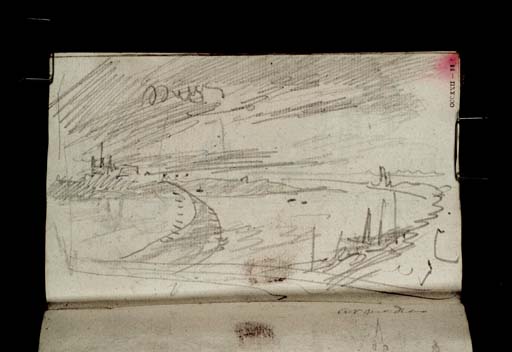Joseph Mallord William Turner ?Deutz Abbey, with the Bridge of Boats across the River Rhine from Cologne 1833
Image 1 of 2
Joseph Mallord William Turner,
?Deutz Abbey, with the Bridge of Boats across the River Rhine from Cologne
1833
Joseph Mallord William Turner 1775–1851
Folio 37 Recto:
?Deutz Abbey, with the Bridge of Boats across the River Rhine from Cologne 1833
D32612
Turner Bequest CCCXXII 38
Turner Bequest CCCXXII 38
Pencil on white laid paper, 105 x 170 mm
Inscribed by Turner in pencil ‘[?Deuz]’ towards top left
Inscribed by John Ruskin in red ink ‘38’ top right, ascending vertically (smudged and faint)
Stamped in black ‘CCCXXII – 38’ top right ascending vertically
Inscribed by Turner in pencil ‘[?Deuz]’ towards top left
Inscribed by John Ruskin in red ink ‘38’ top right, ascending vertically (smudged and faint)
Stamped in black ‘CCCXXII – 38’ top right ascending vertically
Accepted by the nation as part of the Turner Bequest 1856
References
1909
A.J. Finberg, A Complete Inventory of the Drawings of the Turner Bequest, London 1909, vol.II, p.1036, CCCXXII 38, as ‘Do.’ (i.e. ditto: ‘Distant town’).
Made with the page turned horizontally, this is the most heavily worked, consciously ‘pictorial’ sketch in this book, apparently showing a broad river with spires on the skyline beyond, with a tower towards the right beyond what seem to be the masts of moored boats along the gently curving riverbank in the foreground. The drawing is rendered expressively with rapid pencil strokes and rough shading that suggest a stormy day, or perhaps a twilight effect.
The shaded crescent shape and associated horizontal strokes towards the left may indicate a bridge of boats, and the juxtaposition with the spires is comparable with that in a view of Deutz Abbey on the east bank of the River Rhine opposite central Cologne, with its bridge of boats (opened in 18221) indicated by a similar cursory shape, in the 1835 Prague, Nuremberg, Frankfurt and Rhine sketchbook (Tate D30774; CCCIV 75a). If the identification is correct in the present case, the distant tower counterbalancing the abbey would be the medieval Bayenturm, while the word scrawled across the sky may be an attempt at the abbey’s name.
A loose colour study, perhaps of about 1824–32, is unrelated to any finished composition (D25312; CCLXIII 190), but shows a complementary (albeit somewhat fanciful2) prospect of Cologne and the bridge from the east bank, as does an undated pencil and chalk sketch on grey paper (Tate D33685; Turner Bequest CCCXLI 10). A technically similar work to the latter (D34183; CCCXLI 444; see also D33918; CCCXLI 212) appears to depict the same scene as that in the 1835 sketch noted above, and is the most directly comparable with the left-hand half of the present view. Turner had studied the modest abbey church from different angles in 1817, in the Waterloo and Rhine and Rhine sketchbooks (Tate D12873; Turner Bequest CLX 88; D12985, D41396; CLXI 55, 57 verso). Today it is overshadowed by tower blocks to its south, near the modern steel Deutzer Brücke, crossing at about where the bridge of boats seems to be shown here.
As set out in its Introduction, this sketchbook covers Turner’s homeward route from Augsburg north-westwards to Rotterdam (see under folios 1 verso and 14 recto respectively; D32543, D32568; CCCXXII 2a, 15). Travelling back down the familiar river, he worked in somewhat randomly from both ends, interspersing identifiable subjects with less distinctive renderings of towns, castles and the landscape.
The artist’s coverage of Cologne itself on the outward leg of the present tour had been limited to scattered sketches in the Brussels up to Mannheim – Rhine book (Tate D29667, D29678–D29679; Turner Bequest CCXCVI 36a, 42a, 43). His engagement with the city was much more extensive on other occasions, albeit summarised here only in terms of the sketchbooks used (all Tate): 1817’s Itinerary Rhine Tour, Waterloo and Rhine and Rhine (Turner Bequest CLIX, CLX, CLXI); 1824’s Rivers Meuse and Moselle (CCXVI); 1825’s Holland and Holland, Meuse and Cologne (CCXIV, CCXV); 1835’s Prague, Nuremberg, Frankfurt and Rhine (CCCIV); 1840’s Würzburg, Rhine and Ostend (CCCIII); and 1844’s Rhine and Rhine Castles (CCCLI).
There are two 1817 watercolours of the city: Rhine Gate, Cologne (National Museum Wales, Cardiff);3 and Cologne (currently untraced).4 Subsequent watercolours are Cologne, of about 1820 (currently untraced),5 that year’s Cologne from the River (Seattle Art Museum),6 engraved in 1824 (Tate impression: T06068) and 1859 (T05195, T06323), and Cologne, of about 1832–3 (Courtauld Gallery, London),7 engraved for Byron’s Works in the year of the present tour (Tate impression: T06189). A major oil, Cologne, the Arrival of a Packet Boat, Evening, had been exhibited in 1826 (Frick Collection, New York).8 All show the waterfront of the west bank, and the abbey and crossing are visible in the distance of the painting.
Matthew Imms
November 2019
How to cite
Matthew Imms, ‘?Deutz Abbey, with the Bridge of Boats across the River Rhine from Cologne 1833 by Joseph Mallord William Turner’, catalogue entry, November 2019, in David Blayney Brown (ed.), J.M.W. Turner: Sketchbooks, Drawings and Watercolours, Tate Research Publication, March 2023, https://www


